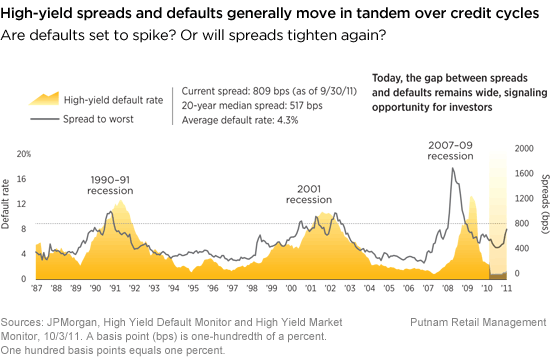After enjoying two years of solid returns, in the third quarter of 2011 investors embarked on a “flight to quality” and all but the safest of asset classes posted significant declines. We believe the sell-off in high-yield bonds actually represents an investment opportunity. It is our view that the severity of the 2008 economic contraction and the resulting high level of defaults purged the global high-yield market of many of its weakest issuers. Today, the bulk of high-yield market participants are stronger, having emerged from the 2008–2009 recession with higher cash levels, improved margins, and largely refinanced capital structures. For these reasons, we believe the market offers an attractive combination of solid fundamentals and compelling valuations.
The survivors in the sector are more fit
What is probably less appreciated about the high-yield market in the wake of the 2008–2009 credit crisis is that approximately 80% to 85% of companies did not default during that period. Generally speaking, these surviving companies aggressively cut costs, improved efficiency, built liquidity, and refinanced debt. In fact, during 2009 and 2010, nearly 70% of high-yield issuance was generated for the purpose of refinancing debt, resulting in extended maturities and more favorable borrowing terms. The surviving, stronger companies have continued to improve their operations, while defaults in the market have been declining. The long-term average default rate for high-yield debt is estimated to be 4.3%. Last year, the default rate was much lower at 2.6%. As of September 30, 2011, the default rate for the trailing 12 months was only 1.2%, less than one third the historical average.
With corporate financial measures improving, valuations appear attractive
Part of the reason defaults have been so low is because companies are now seeing the results of their clean-up efforts reflected in improving fundamentals. In 2011, companies in the S&P 500 are on track to generate record earnings — around $100 per share, on average. Operating margins are quite high, and companies continue to benefit from cost cutting implemented in the 2008-2009 period. They have also remained disciplined by keeping capital expenditures and inventories low.
But despite these attractive characteristics, high-yield bonds suffered one of the worst periods for the asset class in the third quarter of 2011 as investors sold off riskier positions amid fears of a global economic slowdown. While the economic trajectory for developed Europe may be uncertain and the United States is likely to continue to experience continued below-average growth at best, we believe that corporations can weather this environment as they have so far in 2011. Today, the spread — or the difference in yield — between high-yield bonds and Treasuries is unusually high, particularly given the low default rate in a historical context. We believe this makes the asset class worth considering for investors with longer time horizons and the ability to weather short-term volatility.

Lower-rated bonds may offer higher yields in return for more risk.
Read Putnam’s white paper: The case for high yield.
More in: Fixed income, Outlook



